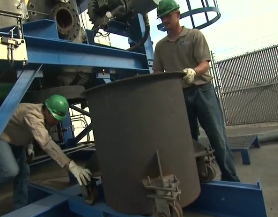
As America's dump-truck-accessible landfill spaces fill to the brim with garbage, where did Waste Management Inc, the nation's $12.5 billion trash hauling king, go to solve this problem? In 2009, along with buying stakes in eight other companies that gasify, ferment, or digest trash, the company found its way to Jeff Surma, a 52-year-old chemical engineer with a unique solution verging on 60s science fiction: a plasma-enhanced melter technology. Since last November, some of the 35,000 tons of household trash arriving by dump truck at Waste Management's Columbia Ridge landfill in Arlington, Oregon, are diverted to a building that looks like a cavernous Home Depot. Attached to it is Surma's unique plasma gasification plant. It's the first commercial plant in the US to use plasma gasification to convert municipal household garbage into gas products like hydrogen and carbon monoxide, which

can later be burned as fuel. Using plasma for processing waste had been around forever, primarily in the metal and chemical industries. Oil refineries, for example, spend about $2,000 a ton to eliminate toxic sludge with plasma gasification. (One of the first plants sold by Surma's company helps Dow Corning dispose of 20 tons of hazardous waste a day.)
Solving the toxic waste problem
In 2005, executives at Waste Management, concerned by the prospect of full landfills, started to quietly study plasma gasification. After reviewing dozens of firms racing to blast garbage into gas, they felt InEnTec's technology looked the most commercially viable. Soon after, Waste Management invested in Surma, founding a joint company, called S4 Energy Solutions, and began building the Oregon plant. But until this new plant was started, no one had seriously considered using the same technology to eliminate everyday garbage. Along with high energy costs, there was another technological barrier: the toxins in heavy metals from televisions, microwaves, batteries, thermometers and paint couldn't be broken down by plasma. And every municipality wanted to prevent hazardous leftovers from getting loose. Fortunately, Surma's special three-step process could handle all of these nasty substances cleanly and efficiently. As a matter of fact, Surma solved the hardest problem first, while he was working at Pacific Northwest National Laboratory: safely disposing of the toxic waste. Watch a short background video:
Surma's three-step process
Each day, in the huge receiving depot, waste is delivered by truck and then shredded into pieces about six inches long. It travels by conveyer belt to the top of a large tank, where it falls into a gasifier heated to

1,500 F, vaporizing 75 to 85% of the waste quickly into syngas that is piped out of the system. In the second phase of Surma's process, any remaining substances (still chemically intact) drop into a vessel about the size of a huge industrial-sized pot. Inside, where an intense 18,000-degree electric arc running between two electrodes creates a plasma zone, almost all the remaining trash gets blasted into its atomic elements. This emission-free molecular deconstruction is even more efficient because the blasted materials have already been partially heated. Afterwards, the final gases are piped out to be processed. Finally, a joule-heated melter sits directly beneath the plasma zone, where a molten glass bath

traps the remaining hazardous material dropping down into a molten goop flowing in a slow ooze of glass and liquefied metal out of the bottom. Once inert and harmless, it is converted into low-value materials such as road aggregate. Ensuring that the process remains economical, syngas piped out of the plant is used to supply all of the power needed to run the melter. Any remaining syngas - mostly carbon monoxide and hydrogen - is cleaned and sold. Here is an early InEntec video that visualizes the final two steps of the process:
The price paid to Waste Management to haul away waste products, at least for now, helps too. In fact, Waste Management charges about $20 to $100 a ton to collect garbage. So based on a typical "tipping fee," profits from selling fuel and chemicals made from garbage are virtually guaranteed. Of course, scaling up is always the last part of the problem. Since the US generates about 250 million tons of trash a year, with recycling and composting facilities tackling an estimated 85 million tons of refuse per year, it would take thousands of new plants much bigger than this one (and another S4 facility being constructed in McCarran, Nevada) to handle the nation's municipal trash output. That's a lot of plasma in our future.


Comments
This is an interesting post. I think it is more likely that Waste Management will transform the waste industry then the energy business - in this single case. I foresee the elimination of landfills, and that this type of model would be a possibility, but I am not sure if it will be the dominate design for handling waste. However, the energy business is too large for this specific technology (plasma/paralysis) to 'transform' the energy industry. I do think, on a higher level, this model will transform the energy industry: i.e. distributed energy. The headwinds seem to favor both closed and open loop small scale distributed energy plays. It seems to me that it is out of necessity Waste Management is entering the energy market, and it seems to be working well. I think they will be a first mover since they have access to feed stocks. I think an interesting company, that Waste Management invested heavily in is: Harvest Power ( <a href="http://www.harvestpower.com/" rel="nofollow">http://www.harvestpower.com/</a> ). I like their approach. They have two revenue streams: biogas (energy) and fertilizer.
Really appreciate your thoughtful post. I agree about distributed energy. I'll investigate Harvest Power. A different approach is worth a post. Waste Management's whole portfolio is interesting. And like you point out, there is so much profitable feedstock piling up that they've been paid to haul there - it's a twofer. Any sensible company would move in that direction.You can't beat that. Thanks.
Waste to energy is a interesting topic. It is riddled with dynamic technology and policies. I have been consulting at a firm named Applied Filter Technology ( <a href="http://appliedfilter.com/" rel="nofollow">http://appliedfilter.com/</a> ) for a little over six months now. We encountered a sludge incinerator that will need to spend some serious money by 2014 to upgrade and meet air requirements ( I think is EPA 219 Clean Air Act.). So, we are familiar with a lot of issues related to this type of operation. The biggest advantage to biogas, over wind and solar, is that it can serve as the base load for utilities. Kent, I see you have several posts. I will be at the AIChE annual meeting. I hope we can meet.
Concentrated solar using salt storage can also supply baseload power and will become more prominent in the US Southwest, Spain and Middle East in the future. I'll see you there.
There is no problem if tipping fee is increasing as long as the elimination of waste is guarantee.